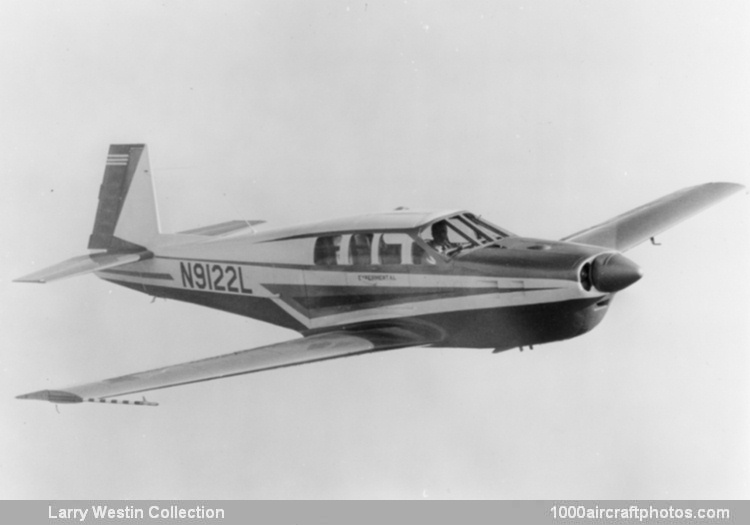The 'second' Mark 22 (M-22) was designed by Ralph Hannon and this five-seater became the first pressurized single-engine light aircraft to be marketed. The pictured prototype was first flown on September 24, 1964, type approval was received on September 26, 1966 and the first delivery of a production M-22 was made on March, 28 1967.
Mooney spent almost $5 million on development of the M-22, including flying a T-tailed version, and when it did enter production it was too expensive to attract many buyers. Even at the very substantial price (for those days) of $ 46,000, Mooney was losing money on it and only 39 units (including the static test airframes) were eventually built."
Type: Five-seat light monoplane.
Wings: Cantilever low-wing monoplane. Wing section NACA 632-215 at root, NACA 641-412 at tip. Dihedral 5° 30'. Incidence 1° 30'. Sweep-forward 2° 29'. Aluminum alloy structure with flush-riveted stretch-formed wrap-around skins. Full-span main spar; rear spar terminates at mid-span of flaps. Sealed-gap differentially operated aluminum alloy ailerons. Electrically-operated double-slotted aluminum alloy flaps over 70% of trailing edge. No tabs.
Fuselage: Conventional aluminum alloy semi-monocoque structure.
Tail unit: Cantilever aluminum alloy structure, with stretch-formed wrap-around skins. Variable incidence tail plane. Vacuum-operated rudder trim. Manual elevator trim.
Landing gear: Electrically-retractable tricycle type. Manual emergency gear extension system standard. Steerable nose wheel retracts rearward, main units inward into wing. Mooney oleo-pneumatic shock-absorbers. Mooney wheels. nose wheel tire size 15 x 6.00 x 6 four-ply rating. Main wheel tires size 6.00 x 6 six-ply rating. Tire pressures: nose 42 lb/sq.in (2.95 kg/sq.cm), main 45 lb/sq.in (3.16 kg/sq.cm). Cleveland two-puck hydraulic disc brakes. Optional dual brakes. Parking brakes.
Power plant: One 310 hp Lycoming TIO-541-A1A six-cylinder horizontally-opposed air-cooled turbocharged engine, driving a Hartzell two-blade metal constant-speed propeller. Two integral fuel tanks in wings, forward of main spars, with total capacity of 92 gal (348 l). Refueling points in top surface of each wing. Oil capacity 31 gallons (13 l).
Accommodation: Standard seating for four persons in individual reclining seats, with central aisle. Optional fifth seat on port side at rear of cabin. Upward-hinged folding door on starboard side of cabin. Space for 270 lb (122 kg) of baggage aft of second row of seats. Baggage door aft of wing on starboard side. Passenger seats removable for cargo carrying or ambulance work. Cabin heating and ventilation system and windshield defrosting system standard.
Systems: Pressurization system, using bleed air from turbo-compressor, utilized above 8,000 ft (2,400 m). Max pressure differential 4 lb/sq.in (0,28 kg/sq.cm). Hydraulic brakes only. Electrical system has 12V 70A alternator for supply to landing gear, flaps, step, nose landing light, vent blower, radio blower, etc. Retractable landing light in starboard wing optional.
Electronics: Provision for wide range of navigation/communications radio, glide slope receiver, DME and transponder to customer's choice. Autopilot optional.
Equipment: Standard equipment includes all necessary equipment and related instruments for cabin pressurization and oxygen system; basic instrumentation and many de luxe features standard. Optional equipment: dual controls, dual brakes, blind flying instrumentation, Hobbs hour meter, rotating beacon, G-meter, internally illuminated placards, Ram II audio control, antennae, external power socket, Plex-Ring lighting and eye-ball type dome and map lights.
